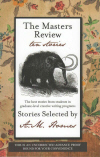The Masters Review – October 2013
It could be said that The Masters Review presents the same value proposition as do The Best New American Voices, The New Yorker’s “20 under 40” fiction showcase, and Poets & Writers listings of leading new poets. That value proposition is the culling of new talent from diverse sources, a way of framing a structure of gifted writers today under the strong light microscope of editorial review.
It could be said that The Masters Review presents the same value proposition as do The Best New American Voices, The New Yorker’s “20 under 40” fiction showcase, and Poets & Writers listings of leading new poets. That value proposition is the culling of new talent from diverse sources, a way of framing a structure of gifted writers today under the strong light microscope of editorial review.
Each story in the collection is cogent—even more so than certain efforts collected in the 2010 New Yorker assembly. But, like the latter, The Masters Review provides a strong place for talent among highly competitive, somewhat collegiate ecosystems, where the echoes of self-expression are deafening. Anthologies, awards, faux-bios of literary icons, echoes of the canon cut the chase. That aspect acknowledged, this collection reflects a purity of narration, a discipline and order to the prose that is effective beyond the storefront promise of the best new bards. These writers remain fantastic messengers, fleet-footed, brave and sure, which is a tough feat when they might be seen to blast the voice of a generation. Taken story by story, they do seem masters of an extraordinary relay—almost like craftsmen carrying a candle through a hurricane.
An especially powerful essay was Courtney Gillette’s “How to Like Girls.” In this endeavor, Gillette joins the second-person renaissance that has blossomed in recent popular fiction (and mainstream media). Complete with the how-to conceit, the essay transcends any renaissance in a frank, funny, perfectly-paced study. I couldn’t put it down and read the ending again and again, not because it is my own mantra in better words, but because it transcends expectations—social, cultural, literary, in its own brave exuberance of love:
Like girls. Even when you don’t get what you want. Even when your mother accuses you of just never having met the right guy. Even when you get called names. Even when the girls you like cheat on you or . . . break your heart . . . or never call you back. Wake up the next day and do it again. Believe that love exists. Live in a city where girls like girls. Smile. Go up to her and say hello.
Throughout her prose, you feel the energy—the magic of ebullience, the thoughtful, surprising adjectives and dramatic crescendo of her paragraphs.
Gillette’s talent keeps fine company with the other writers in this year’s issue of The Masters Review. Jennifer Dupree suggests a surreal pregnancy in the context of the modern American newsroom, bookending a new kind of life against the essay that ends the collection, Traci Cox’s work about the end of a life, the closure of motherhood, the ravages of sorrow when one loses a parent.
The stories cannot be examined as variations of a theme, which makes it versatile literature. Should you tire of realism, you might read Dustin M. Hoffman’s strange trip through a looking glass. Should you tremble on the expectations of adulthood, try Jane Summer’s “Peaceful Village,” a timeless parable against terrifying uncertainty. Laurie Ann Cedilnik’s “Sunshiny Days and Mostly Clear Nights” nodded neatly to a modern Scott Fitzgerald with a kind of even prose that propels the story’s passion. Zoe Vandeveer’s “Coffee for Dead Children,” which, like Cedilnik’s story, is narrated by a young woman, is chilling, partly because the story’s structure and subject matter and partly because the writer has hit a new archetype squarely on its head. These are not “chick lit,” or the formula of it per se, but you feel them graze the sensibility of a young woman coming of age, or drowning in it, as the case may be, and they have amazing, arresting pull.
On the website for this year’s collection, the editors specify innovation and “authenticity” as criteria for inclusion. The diversity of voices and styles seems to support these aims. And while generalizations are not empirical, because the editors list the names of each writer’s graduate school, you might construe a particular aesthetics from a graduate of the respective institution.
The ten stories in The Masters Review foretell an inspiring future of American letters if these writers maintain their course. They signal more than talent; they suggest a willingness to experiment significantly, to examine a theme thoughtfully and, like the metaphor referenced above, to convey the flame and anchor the story down in the event of wind.
[mastersreview.com]





